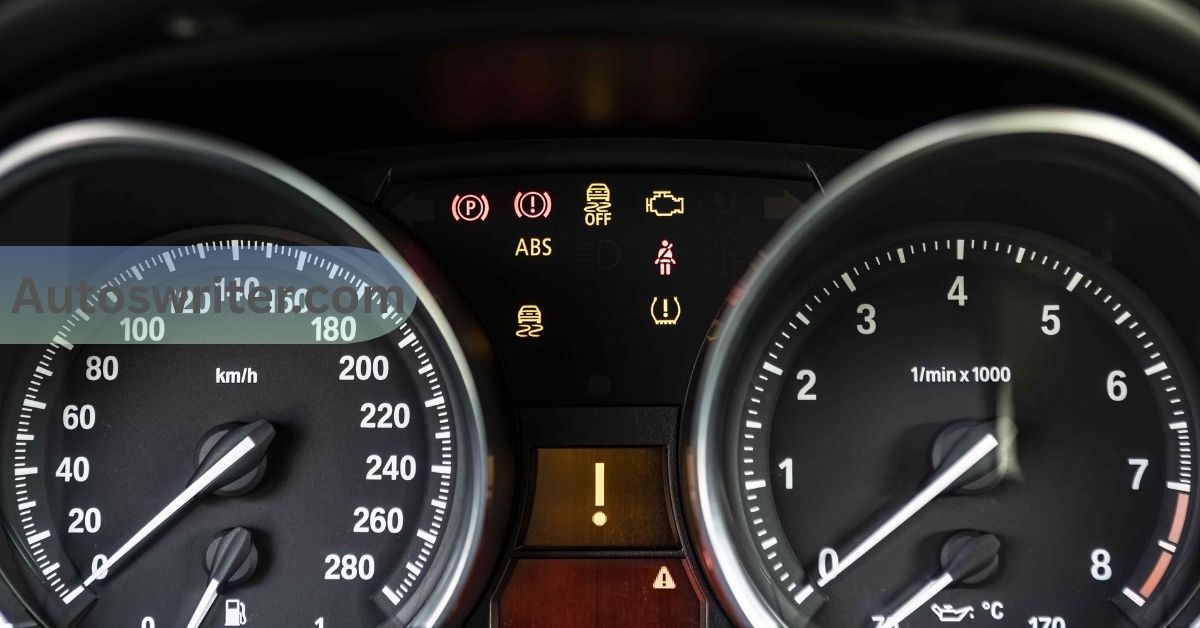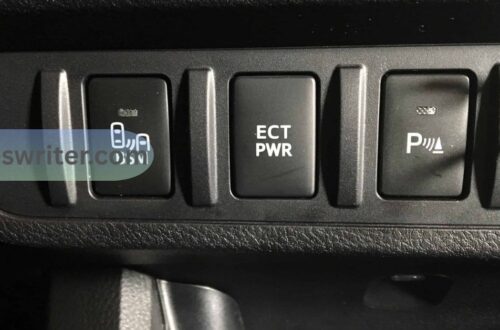The small orange (yellow) exclamation point on a Toyota’s dashboard is a warning symbol. It alerts you that something needs attention in your vehicle. The exact meaning depends on the shape of the icon.
For example, an exclamation mark inside a tire-shaped symbol indicates low tire pressure, while an exclamation mark inside a triangle signifies the “master warning” light for other issues.
An exclamation inside a circle usually means a brake problem. Toyota models similarly utilize these lights: the 2020 Corolla, 2021 Camry, 2025 Highlander, Prius, Corolla Cross, and RAV4 all display the same symbols.
Tire Pressure Warning (TPMS Icon):
A tire-pressure warning symbol resembles a U-shaped horseshoe or an open circle with an exclamation mark inside. This means one or more tires are significantly under-inflated.
The Toyota message is clear: “It indicates low tire inflation pressure.” When this light comes on (often yellow or orange), pull safely off the road and check your tires immediately.
Likely cause: A tire has lost air (a slow leak, puncture, or standard pressure drop in cold weather).
Models/Years: Every Toyota vehicle equipped with a Tire Pressure Monitoring System (TPMS) displays this symbol. In the US and many countries, TPMS became standard around 2008 or later. So Corollas, Camrys, RAV4s, Highlanders, Priuses, Corolla Crosses (and nearly all Toyota cars and SUVs manufactured since 2010) will display it.
What to do:
- Stop and inspect the tires. Look for flat or soft tires.
- Check pressures with a gauge. Use a tire pressure gauge to measure the pressure in each tire. Compare to the recommended PSI on your vehicle’s sticker (usually on the driver’s door jamb). For many Toyotas, normal pressure is around 30–35 PSI (typically about 32 PSI front and 29 PSI rear) when cold. Inflate any low tire to the correct PSI. Toyota’s Highlander guide advises pumping up the tire “to the appropriate level” on the pump.
- Include the spare tire. If your Toyota’s spare is full-size and has a sensor, check that too. Some Toyota manuals instruct users to “adjust the tire inflation pressure (including the full-size spare) to the specified level.”
- Reset the TPMS if needed. Many Toyotas reset automatically a few minutes after you fill the tires and drive. Some have a reset button or a menu setting in the multi-information display. For example, the Corolla, RAV4, Highlander, and other models utilize a “Vehicle Settings” menu on the dashboard screen to reset the Tire Pressure Monitoring System (TPMS). Follow your owner’s manual steps if the light stays on.
If the light stays on or flashes after inflation, there may be a sensor fault. Toyota recommends having the system checked by a dealer if the warning is not clear. Do not ignore this warning: low tire pressure reduces fuel economy and can be hazardous. Once the tires are properly inflated, the symbol should turn off after driving a short distance.
Also Read: How Long Do Toyotas Last-Everything You Need to Know
Master Warning Light (Triangle with !):

A triangle with an exclamation mark (often yellow or red) is Toyota’s Master Warning light. This is a catch-all alert. It means the car has detected one or more problems somewhere. Often, it is accompanied by a chime and/or message on the multi-information display.
1. Likely causes:
The master warning light can indicate various issues. Typical examples are a door or hood left ajar, low washer fluid, or a fault in a safety system. On hybrid models like the Prius, the master warning (often displayed as a red triangle) typically indicates a serious issue with the hybrid system or engine – for example, a failing hybrid battery.
2. Models/Years:
Almost all recent Toyotas (Corolla, Camry, RAV4, Highlander, Prius, etc.) have this light. The Camry guide confirms a flashing exclamation point in a triangle. It has appeared on Corollas and Camrys since at least the 2010s. Hybrid Toyotas (Prius, Camry Hybrid, RAV4 Hybrid) often use a red master warning, which is nicknamed the “Red Triangle of Death” because it signals primary hybrid or engine problems.
3. What to do:
- Check for messages: Many Toyotas display a warning message on the dashboard when the master light comes on. Scroll or look at the multi-information display (MID). For example, some Corollas have a “Warnings” section that explains each alert in detail. The symbol may appear together with another icon (like “Door Open” or “Low Washer Fluid”), so pay attention to any accompanying text or lights.
- Perform basic checks: to identify any apparent issues. Are any doors, the trunk, or the hood not fully closed? Is the parking brake still on? Is a seatbelt unbuckled? Address simple issues.
- Stop driving if serious: If the master warning is red or the car behaves oddly, pull over safely. CarParts.com advises against driving with this light on and recommends having a mechanic inspect the vehicle as soon as possible.
- Inspect critical systems: Master warnings can coincide with ABS or brake lights, engine lights, and other indicators. If you also see brake warnings or the engine icon, take those seriously (see sections below). On a Prius, a “Master Warning” often means the hybrid battery needs service.
In short, treat the master warning as a prompt to identify the issue. Check the MID or owner’s manual for details. If you cannot identify or fix the problem, have your Toyota inspected.
Brake System Warning (Circle with ! or “BRAKE” ):
An exclamation point in a circle (sometimes accompanied by two side brackets) typically indicates a brake system warning. (Some cars use red for this.) It means your Toyota’s brake system needs attention. Often, it appears that the parking brake is on or that the brake fluid is low.
1. Likely causes:
The most common causes are that the parking brake (handbrake) is still engaged or brake fluid is low. It can also mean worn brake pads or an ABS fault. In any case, it should be taken seriously.
2. Models/Years:
All Toyotas with hydraulic brakes have this warning. On many dashboards, the light says “BRAKE” (in red). But some vehicles use the! Symbol. Either way, it has been used on the Camry, Corolla, RAV4, Highlander, Prius, and other models for many years.
3. What to do:
- Release the parking brake. If you forgot to lower the parking brake fully, do so now. Toyota notes that this warning will turn off once the brake is released.
- Check brake fluid. Locate the brake fluid reservoir, which is typically located under the hood. If the level is near or below the “MIN” mark, add the correct type of brake fluid safely. (The Toyota owner’s manual will say which type to use.) Low fluid can trigger this light.
- Inspect for leaks or wear. If the fluid level is very low, check around the wheels for leaks and have the system examined. Also, very worn brake pads can sometimes cause sensors to trigger.
- Test brakes carefully. If you notice any sponginess or reduced braking, stop driving.
If the light remains on after you release the parking brake and refill fluid, do not continue driving. Towne Toyota’s dashboard guide warns: “Immediately stop the vehicle in a safe place and contact your Toyota dealer. Continuing to drive may be dangerous”.
Generally, brake warnings should be treated as an emergency. As one source advises, get your brakes inspected as soon as possible if a brake warning appears.
Vehicle Stability Control (Triangle or Car Icon):
Toyota’s Vehicle Stability Control (VSC) system helps keep your car from sliding. A special icon (car with squiggly lines) usually flashes when the system is in use. However, an exclamation mark inside a triangle can also mean a stability-control problem. In Toyota parlance, this is referred to as VSA (Vehicle Stability Assist).
1. Likely causes:
This icon lights up if VSC detects a fault or has been turned off. It often comes on together with “VSC OFF” or “TRAC OFF” if you switch off traction control, but if it appears alone (especially with the !), there may be a system error (such as a bad wheel speed sensor or an electrical fault).
2. Models/Years:
Nearly all modern Toyotas (Corolla, Camry, RAV4, etc.) have VSC. If you see an orange triangle with an exclamation point, one Corolla owner noted that it “stands for your vehicle’s Vehicle Stability Assist system” and indicates an issue has been detected. The slip/skid icon (a car with skid marks) is also standard when the wheels lose traction.
3. What to do:
- Release the parking brake. If you forgot to lower the parking brake fully, do so now. Toyota notes that this warning will turn off once the brake is released.
- Check brake fluid. Locate the brake fluid reservoir, which is typically located under the hood. If the level is near or below the “MIN” mark, add the correct type of brake fluid safely. (The Toyota owner’s manual will say which type to use.) Low fluid can trigger this light.
- Inspect for leaks or wear. If the fluid level is very low, check around the wheels for leaks and have the system examined. Also, very worn brake pads can sometimes cause sensors to trigger.
- Test brakes carefully. If you notice any sponginess or reduced braking, stop driving.
If the light remains on after you release the parking brake and refill fluid, do not continue driving. Towne Toyota’s dashboard guide warns: “Immediately stop the vehicle in a safe place and contact your Toyota dealer. Continuing to drive may be dangerous”.
Generally, brake warnings should be treated as an emergency. As one source advises, get your brakes inspected as soon as possible if a brake warning appears.
Also Read: Titus Will Toyota Tacoma WA-Complete Buyer’s Guide
Vehicle Stability Control (Triangle or Car Icon):
Toyota’s Vehicle Stability Control (VSC) system helps keep your car from sliding. A special icon (car with squiggly lines) usually flashes when the system is in use. However, an exclamation mark inside a triangle can also mean a stability-control problem. In Toyota parlance, this is referred to as VSA (Vehicle Stability Assist).
1. Likely causes:
This icon lights up if VSC detects a fault or has been turned off. It often comes on together with “VSC OFF” or “TRAC OFF” if you switch off traction control, but if it appears alone (especially with the !), there may be a system error (such as a bad wheel speed sensor or an electrical fault).
2. Models/Years:
Nearly all modern Toyotas (Corolla, Camry, RAV4, etc.) have VSC. If you see an orange triangle with an exclamation point, one Corolla owner noted that it “stands for your vehicle’s Vehicle Stability Assist system” and indicates an issue has been detected. The slip/skid icon (a car with skid marks) is also standard when the wheels lose traction.
3. What to do:
- Check for off-road conditions. If you’re in deep snow or mud and deliberately turn off traction (to rock-free), the light will usually be on. In that case, turn VSC back on after you move.
- Restart the car. Sometimes, if this light comes on along with another warning (such as the check engine light), restarting can clear a temporary fault.
- Observe handling. If your car feels unstable or the engine light is on, pull over.
- Get service if needed. If the VSC warning stays on with no improvement, have your Toyota checked. A technician can scan for ABS/VSC codes.
Because VSC can tie to braking and ABS, it’s safer to diagnose promptly.
Power Steering Fault (Steering Wheel + !):

Some Toyotas show a small steering wheel icon with an exclamation point when there is a problem with the Electric Power Steering (EPS) system. This symbol warns that the power assist to the steering is not working correctly.
Likely causes:
An issue with the power steering motor or sensors. It may indicate you’ll lose power assist (the wheel will be harder to turn).
Models/Years:
Many newer Toyotas (e.g., Camry, Corolla, Highlander) use electric steering and have this light. It’s shown in the 2020 Corolla guide as a steering wheel with an exclamation mark.
What to do:
If this light comes on, pull over safely. Try turning the engine off and on again. If the light persists, your steering may have lost power assist, making the car harder to steer. Have your Toyota inspected before driving again. The manufacturer advises any power steering warning needs a technician’s attention.
What to Do When the Light Appears:
- Stay calm and safe. Pull over when it’s secure. Use turn signals and caution.
- Identify the symbol. Look at the icon closely. Is it in a tire, triangle, circle, or steering wheel? Knowing which symbol it is tells you what to check first.
- Check messages on display. Many Toyotas will show a text message on the multi-information display (MID) or head unit telling you why the light is on. Scroll through the warnings screen. It may display messages such as “Low Tire Pressure,” “Brake,” or “Door Ajar,” among others. This message can guide your next step.
Follow the checklist:
- If the warning displays a tire icon, check the air pressure in each tire using a tire pressure gauge. You can refill them at most gas stations—inflate them to the PSI level listed on the sticker inside the driver’s door or in your owner’s manual. Typical values are ~32 PSI front and 30 PSI rear on many Toyotas, but follow your car’s label for accurate information. After filling, drive for a few minutes, and the light should turn off.
- If it’s the parking brake or brake fluid symbol, release the parking brake fully and check the brake fluid level. Add fluid if low. If the light still shows, have the brake system checked immediately.
- If it’s the triangle (master) symbol, note any other lights on. Check the doors, hood, and seatbelts, and review the MID for any messages.
- If the symbol relates to Vehicle Stability Control (VSC) or traction, first confirm whether the VSC system has been manually switched off or if road conditions are triggering wheel slip. Restart the vehicle to see if the light clears. If the warning remains, a professional inspection is recommended.
- If it’s the steering wheel symbol, stop the car and reboot it. If the emblem stays, don’t drive; tow or call for service.
Drive cautiously. If it’s not an urgent red warning, you may be able to drive slowly to a safe spot or service center. But do not ignore a red or persistent light.
Troubleshooting and Next Steps:
Sometimes, a warning light may not go away immediately. Here are some tips:
1. Wait and monitor:
After correcting a low tire or minor issue, the system may take a minute to reset. For example, the TPMS light should blink and then turn off after you fill a tire and drive for a short time. If the tire light blinks for a minute and then stays on, Toyota states that this indicates a malfunction in the TPMS system and recommends that the vehicle be taken to a dealer for inspection.
2. Reset the system:
Some Toyotas require you to hold a TPMS reset button or select “Initialize Tire Pressure” in the settings after filling tires. Consult your owner’s manual.
3. Check sensor issues:
A sudden loss of air pressure might indicate a torn valve stem or faulty sensor. If you repeatedly get low-pressure warnings after pumping, there may be a leak or broken sensor.
4. Inspect again:
If the brake or steering warning light remains on, double-check your actions. For brakes, ensure the brake fluid cap is closed securely and that no leaks are visible. For steering, ensure the engine doesn’t shut off.
5. Use an OBD scanner (if available):
Master warning often comes with trouble codes. A generic OBD-II scanner might reveal a code pointing to the faulty system (ABS, engine, airbag, etc.).
6. Seek professional help:
If you cannot clear the light or identify the cause, or if the warning returns repeatedly, stop driving the car immediately. For safety, contact a Toyota technician or qualified mechanic.
When to Contact a Toyota Technician:

Some warnings should not wait:
1. The red brake warning stays on:
If your brake system light (circle/”BRAKE”) remains illuminated despite the parking brake being engaged and sufficient fluid, stop driving. This could mean a leak or brake failure.
2. Red master warning (especially on a hybrid):
A red triangle in a Prius or Camry Hybrid almost always means a serious hybrid or engine problem. Have it diagnosed immediately. CarParts.com warns: do not drive with the master warning on – have a mechanic inspect your car right away.
3. Repeated TPMS light:
If the tire symbol won’t clear after proper inflation, or if it blinks, have the TPMS system checked by a Toyota technician. The official guidance is to adjust tire pressure to specification and, if the light still does not clear, get the system checked.
4. ABS or stability warning is also on:
If your ABS or stability control lights come on (often accompanied by a car skidding icon), especially with an exclamation point, your brake or traction system needs service.
5. Any ambiguous warning:
If you are unsure what triggered the exclamation mark or if multiple warning lights appear, see a dealer. It’s better to be safe. As one brake-warning guide says, these lights may seem minor, but if ignored, the problem could worsen. Get it checked to avoid brake failure.
In general, if a warning persists and you cannot easily resolve it, have a professional Toyota technician inspect it. Modern Toyotas are complex; a specialist can use the correct tools and parts. Catching issues early keeps you safe and may save costly repairs later.
Frequently Asked Questions:
Q1. What does the orange triangle with an exclamation mark mean in a Toyota?
It’s the Master Warning Light. It typically signals a general issue—anything from a loose fuel cap to low washer fluid or a more serious system alert. Refer to the dashboard display for additional information.
Q2. Can I drive my Toyota with the tire pressure warning light on?
You can drive short distances to a safe location, but it’s not recommended for long trips. The warning indicates that one or more tires are underinflated, which can reduce handling and fuel efficiency and may lead to tire failure if left unaddressed.
Q3. How do I reset the tire pressure light in my Toyota?
After inflating all tires (including the spare, if it has a sensor) to the correct PSI, the light often resets automatically after driving for a few minutes. Some models require the use of a reset button or selecting a TPMS reset option in the vehicle’s settings menu.
Q4. Is it safe to drive with the brake system warning light on?
No. If the light stays on after releasing the parking brake and checking fluid levels, it may indicate a serious problem with your brakes. Stop driving immediately and have the vehicle inspected.
Q5. Why is the power steering warning light showing on my Toyota?
This symbol (a steering wheel with an exclamation point) means there may be a fault in the electric power steering system. If the wheel feels harder to turn, stop the car and have it checked by a qualified technician.
Conclusion:
An orange exclamation mark on your Toyota’s dashboard is not something to ignore—it’s your car’s way of asking for attention. Whether it’s a tire pressure alert, master warning, brake system issue, or traction control fault, each variation of the symbol indicates a specific problem.
The key is to recognize the shape of the icon (tire, triangle, circle, steering wheel) and follow the appropriate steps. In many cases, the fix is simple: inflate a tire, release the parking brake, or check fluid levels.
But if the warning stays on or you’re unsure about its cause, don’t take chances—have a Toyota technician inspect your vehicle. A timely response not only keeps you safe but can also prevent further damage or costly repairs down the line.



